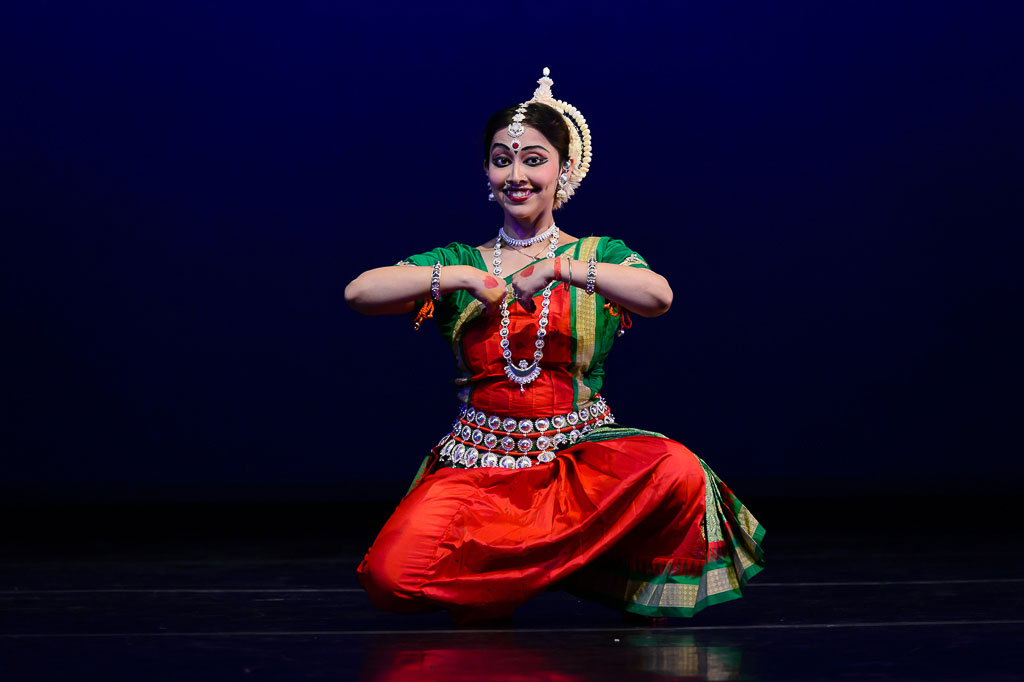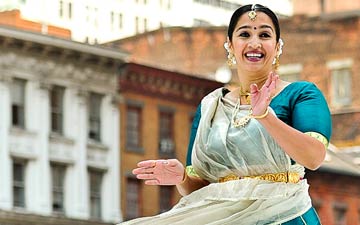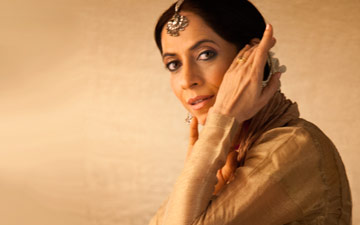
© Darial Sneed. (Click image for larger version)
Erasing Borders Festival of Indian Dance
Featuring: Aishwarya Balasubramanian, Pallavi Krishnan, Rakesh Sai Babu , Aparupa Chatterjee, and Sanjukta Wagh
New York, Michael Schimmel Center for the Arts
27 August 2015
www.iaac.us
schimmel.pace.edu
Dancing in Time
Late summer has become the season of Indian classical dance in New York, thanks to the efforts of the Indo-American Arts Council (IAAC). A few weeks ago we had the first instalment of the “Erasing Borders Festival of Indian Dance,” held outdoors as part of the Battery Dance Festival, with its stunning views of New York Harbor. Part 2 was held indoors at the Michael Schimmel Center for the Arts at Pace University on August 27. Three of the dancers were the same, Sanjukta Wagh, Rakesh Sai Babu (the lone male) and Pallavi Krishnan. They were joined by two more, Aishwarya Balasubramanian and Aparupa Chatterjee. As on the previous evening, various schools of Indian dance were on view, revealing fascinating echoes and differences between them.

© Darial Sneed. (Click image for larger version)
The most unique, and unfamiliar, of the techniques was Mayurbhanj Chhau, a martial-arts-based dance from the eastern state of Orissa. It was performed by the young Rakesh Sai Babu, descended from a long line of Chhau dancers. As he had at the earlier outdoor performance, Sai Babu revealed Chhau’s great plasticity, its way of propelling the body through space with a swaying-rocking-gliding motion, transforming the dancer into a kind of space-devouring giant, a hero of myth. This quality, mixed with a slight irony in the eyes, a profusion of acrobatic feats – backbends, splits, barrel jumps and the like – and provocative shoulder-shakes make for a dance that is both visceral and, in some strange way, balletic. As in ballet, the body is displayed from all sides, stretched, twisted and held in seemingly impossible balances; one pose, in which Sai Babu held one foot with his hand, leg raised to chest level, was so reminiscent of a moment from Balanchine’s Four Temperaments I almost gasped in recognition. (Could Balanchine have seen Chhau? I doubt it.) The accompaniment consisted of bagpipes, chants and drums, like a processional, with periodically shifting rhythms.

© Darial Sneed. (Click image for larger version)
The theme of the evening was an exploration of the ways in which movement and poetry relate to each other. (One compelling aspect of Indian dance, which is usually set to vocal music, is the way codified gestures and expressions illustrate text.) Poems were read, in their original language and in English, before each piece. The Chhau entry was the least representational of the five, though it too was described in program notes as a danced allegory illustrating the five manifestations of energy in Shiva’s dance of bliss. Other dances, like Pallavi Krishnan’s Pingala and Aparupa Chatterjee’s Brajaku Chora, were more obviously literal. Both made ample use of abhinaya i.e. the art of expressing ideas and emotions through the face and body. The latter was set to an Oriya folk song, a lullaby for the infant Krishna, and danced in the Odissi style. Though the piece was less crisply danced than the others and dragged at times – too much repetition – it had a charming immediacy. It offered up a perfectly legible scene: a mother cajoling her baby to sleep, and finally falling asleep herself. At times Chatterjee switched roles, becoming the crying, stomping infant before reverting back again.

© Darial Sneed. (Click image for larger version)
Pallavi Krishnan’s Pingala, in the Mohiniyattam style (from Kerala), was accompanied by a poem in the Malayalam language about a wealthy courtesan who stumbles upon devotion and redemption through her love of Lord Rama. Krishnan, a subtle actress, created an extremely moving portrait of a seductive, powerful woman laid low by a spiritual crisis. (One can’t help but think of the biblical tale of Mary Magdalen, washing Christ’s feet with her hair.) Krishnan’s eyes, so alluring and knowing at the beginning of the dance, were a striking example of sringara, the erotic aspect of Indian dance as described in ancient dance treatises. (Later they filled with tears of awe.) Her hands, which had caressed an invisible lover and strewn imaginary flowers, went limp, as her body crumpled to the floor in her complete abasement before the god.

© Darial Sneed. (Click image for larger version)
Sringara was the dominant mode of the final work as well, Orange Butterflies and Aqua Sequins, performed by the Kathak dancer, Sanjukta Wagh, and set to an excerpt from the 1974 play, “For Colored Girls Who Have Considered Suicide When the Rainbow is Enuf,” by the African-American poet Ntozake Shange. This awkward-sounding amalgam of 1970’s urban poetry and Indian music worked better than one might have imagined, mainly because of Wagh’s ability to project the character’s sensuality through her voice and movements. As theatre it worked, but as dance it was a disappointment: for the most part, the number consisted of walking and talking, with a few flourishes of the hands and spins near the end.

© Darial Sneed. (Click image for larger version)
The most dazzling dancing of the night came from the US-based Bharata Natyam dancer, Aishwarya Balasubramanian, in the piece Ajapa Natanam, set to a prayer to Shiva in Telugu. Balasubramanian is an imposing dancer – her movements are clear, decisive, strong. The shapes she creates have the solidity and seeming permanence of sculpture. (It helped that Balasubramanian was covered in gold, like a sacred statue.) Her eyes danced with as much vitality as her limbs, marking rhythm, changes of mood, shifts in direction. Wherever Balasubramanian stood, one could feel her eyes’ steely, inhuman gleam. Her dance ended spectacularly: at first she advanced in a forward-moving shuffle with her legs bent in a deep plié, her torso completely still, as if she were gliding on a cushion of air; then her chest began to heave, as if gulping in the air of the entire cosmos; then she slowly rose to a relevé position, suspended in space, seemingly imbued with divine powers. For a moment, time stood still.

















You must be logged in to post a comment.